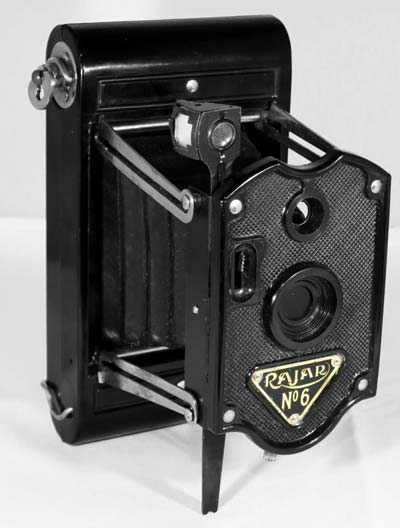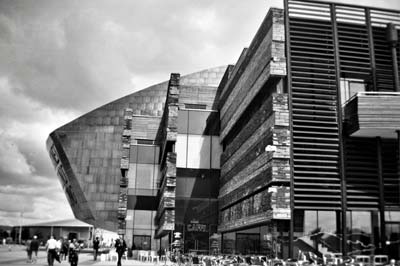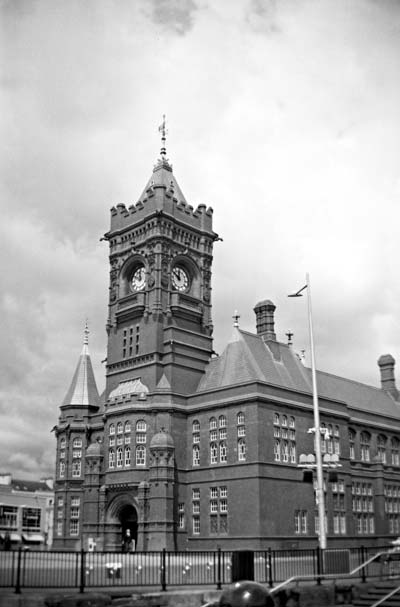Rajar No.6
Specification

| Manufacturer | : | Rajar |
|---|---|---|
| Produced | : | 1929 |
| Classification | : | Medium Format |
| Body Type | : | Folding Strut |
| Construction | : | Bakelite |
| Film Type | : | 120 (with adapter) |
| Film Width | : | 62mm |
| Image Size | : | 2¼ x 3¼ |
| No. of Images | : | 8 |
| Lens Type | : | Meniscus |
| Focal Length | : | 85mm |
| Focus Type | : | Fixed |
| Focal Range | : | 6ft - inf. |
| Aperture Type | : | Fixed |
| Apertures | : | f/12 |
| Shutter Type | : | Rotary |
| Shutter Speeds | : | T, I*(1/50s) |
| Size Open (w x h x d) | : | 108 x 165 x 120 mm |
| Size Closed (w x h x d) | : | 108 x 165 x 43 mm |
| Weight | : | 460g |
| * Measured on this camera | ||
Art Deco Credentials
![]()
![]()
![]()
![]()
![]()
Iconic: Famous, well-known and celebrated
- Produced during the main Art Deco period.
- Built almost exclusively of Bakelite.
- Decorative line mouldings to Bakelite body.
- Decorative cross-hatch mouldings to Bakelite lens plate.
- Chrome used on struts.
- Chrome used on film advance key.
- Triangular name plate with chrome Deco lettering
- Concentric stepped circles on lens bezel.
Description

This camera was the first strut folder to have the body, the back and the lens standard, made of Bakelite. The camera was introduced in 1929. It is a basic camera with meniscus lens and an everset shutter. Instant and time modes are available. Film advance is by a key. It has a reflecting type viewfinder mounted above the lens opening behind a hole in the lens standard. For horizontal exposures, the viewfinder can be swung out so that the finderis positioned over the standard. The shutter release lever is placed below the lens standard and has a flip-flop action. Flip it one way to take a picture and the other to take the next picture.
The camera produced eight 6×9cm exposures on special Rajar No.6 film rolls - hence its name. The square film drive of this camera fits the No.6 film but by using an adaptor, 120 film can be used.
This camera was distributed through premium schemes. For example, Godfrey Phillips who were makers of cigarettes and other tobacco products in the 1930's, offered this camera in exchange for 150 coupons.
How to Use
With the use of an adapter, this camera takes 120 film which is widely available.
The aperture is set at about f/12. The measured speed on this camera was 1/45s when the shutter lever was moved one way and 1/55s when moved the other way. Therefore the average was 1/50s. As the shutter speed is only 1/50s, it is advisable to use a tripod to get clear shake free images. However, holding it against a wall or other solid object would work as well. For quick snapshots, hold it firmly against your body.
The table shows how this camera will perform using ISO 100/125 film. It is based on the 'Sunny 16' rule. Modern film is so forgiving and will produce acceptable results even when overexposed by 2 or 3 stops or underexposed by 1 stop.
The tables assume that the sun is at least 30 degrees above the horizon - that's 10am - 5pm on a summers day in the UK.
Remember that the exposure guide in the manual may not be helpful as it is based on the use of old film with a low ISO value.
Using ISO 100/125 film - shutter speed 1/50s
| Weather Conditions | Shadow Detail | Aperture | Exposure |
|---|---|---|---|
 Sunny SunnySnow/Sand | Dark with sharp edges | f/12 | +3 Stops Overexposed Acceptable |
 Sunny Sunny | Distinct | f/12 | +2 Stops Overexposed Acceptable |
 Slight Overcast Slight Overcast | Soft around edges | f/12 | +1 Stops Overexposed Acceptable |
 Overcast Overcast | Barely visible | f/12 | Good |
 Heavy Overcast Heavy Overcast | None | f/12 | -1 Stops Underexposed Acceptable |
 Open Shade Open Shade/Sunset | None | f/12 | -2 Stops Underexposed Not Acceptable |
Photographs taken with this Camera
This camera had pinholes in the bellows. See how I worked around this here:- Quick Fix for Bellows with Light Leaks



